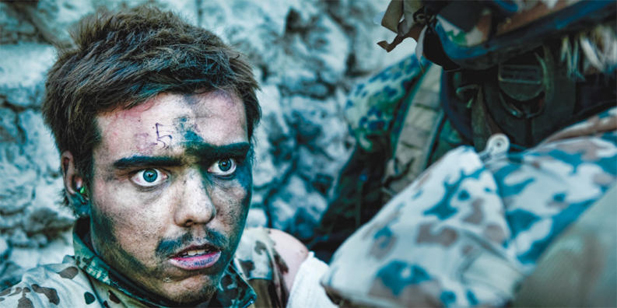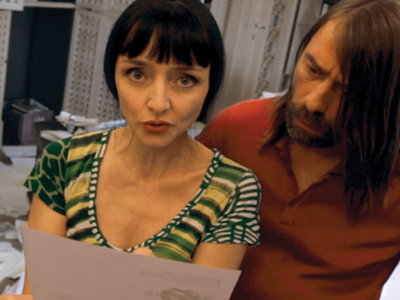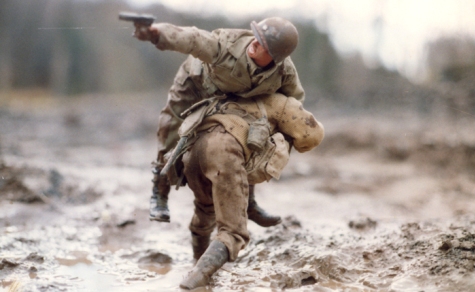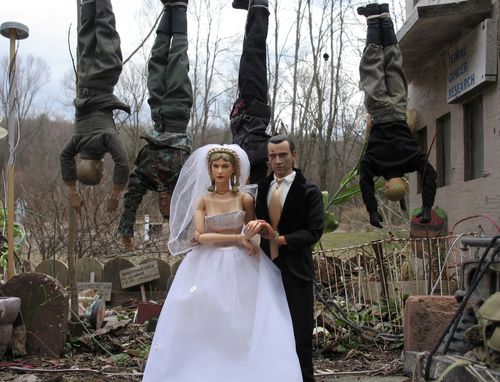
Scene from Janus Metzs feature debut documentary, "Armadillo".
Documentaries from Karlovy Vary International Film Festival
The US may have led the way in championing the feature documentary ““ non-fiction film, as some like to call it ““ but the Europeans have picked up the lead. As in so many other pursuits, they are holding their own, and often outpacing us. The Karlovy Vary International Film Festival in the old spa town of Carlsbad in the Czech Republic was one of first major European festivals to institute a documentary competition. Others, like Berlin, are including more documentaries on their programs. Americans would do well to take notice. To be fair, Sundance has had a world documentary competition for years.

Maria de Medeiros in "Hitler in Hollywood"
The most prominent documentary at KVIFF was a mock-umentary to be exact: Hitler in Hollywood by the Belgian director Frederic Strojcher. For marketing purposes, it never hurts to have Hitler in a films title, but this was anything but Hit-sploitation. The madcap story follows the trail of an international conspiracy to exterminate the European film industry, and the plotters are the Nazis and Hollywood. “Archival” footage documents studio execs meeting the Fuhrer. The goal is put in the words of Franklin Delano Roosevelt: “Send them our productions, and theyll soon be buying our products.” It seems to have worked. Investigating the global crime is none other than Maria Medeiros , the Portuguese actress known to most Americans from her role in Pulp Fiction. Shes even better here. Central to her jaccuse is the French actress Micheline Presle, who acted in France and in Hollywood, and testifies to the power of Tinseltown.
Hitler in Hollywood makes as many allusions to cinema as anything by Tarantino. The conspiracy here is mostly for laughs, even though it began as the directors academic research project. And there is a real corpse ““ European cinema. I wont give the rest of this clever farce away.

Scene from Helena Trestikova's "Katka"
You wont be laughing after seeing Katka, Helena Trestikovas documentary about 14 years in the life of a junkie whom the director follows through late adolescence, childbirth (as we watch), and endless failed therapies. Miraculously, Katka gives birth to a beautiful and surprisingly camera-ready girl, but cant bring her own habit under control. Trestikovas camera is a witness, rather than a judge ““ although its hard to see Katkas life as anything but a tragedy. In adolescence, Katka bears an uncanny resemblance to the American actress Juliette Lewis. Her rapidly fading beauty is the least of what she loses in this wrenching film, and the camera is right there at the worst moments. Katka is likely to be at al the doc festivals this fall. Katkas drugs, consumed on Pragues streets, may well come from Afghanistan.

Scene from Janus Metz's feature debut documentary, "Armadillo".
The “coalition” offensive against the Afghan Taliban, for which US troops are augmented by European allies, is the subject of Armadillo (top and above), a Danish documentary that is Janus Metzs feature debut. The title comes from a base in southern Helmand province from which the unit operates. Metz films the pro forma tearful departures and the fears of young volunteers confronting the “ground truth” of bullets flying at them and the boredom of viewing porn dvds in their tents, all of which the camera observes at close range. Metz and his cinematographer Lars Skree are also there when a well-targeted grenade from the Danes kills a band of Taliban fighters who have pinned them down. The Danes finish off their adversaries at point-blank range. The soldiers unrestrained celebration of their small victory (we watch as two are decorated) triggered outrage in Denmark, where opposition to the war is strong. Investigators are now probing the execution of the wounded Taliban. Dont expect any convictions. In contrast to Sebastian Jungers nuts-and-bolts Restrepo, Armadillo brings an aesthetic eye to the war documentary genre, as stark mountains in the distance frame the field of operation, and the camera lingers on the green farmlands and silent stone structures where the Danish squad never seems to find friends. It also doesnt hurt the films allure that some of these young troops look like movie stars.

Scene from Marwencol
If Armadillo brought a cinematic perspective to war, Marwencol, (above and below) an exceptional American documentary (with an inner story set in Europe) in Karlovy Varys documentary competition, brought a perspective that is as odd as it is improbable. In this quirky documentary winner from SXSW in Austin, Jeff Malmberg steps inside tabloid story from 2000. Mark Hogancamp, a longtime alcoholic, is beaten almost to death by thugs after he leaves a tavern in Kingston New York. When he awakes from a coma, he has lost his memory and, bizarrely, his dependency on drink. Without insurance or cash, he devises an odd therapy, creating Marwencol, a mini-world of a World War II camp in Belgium with doll-sized US soldiers fighting Nazi figurines. If this doesnt return him to “sanity,” his photographs of the project, shown in Chelsea, produce one of the New York art worlds unusual talents.

Marwencol
Among documentary filmmakers, Marwencol is one of the most-praised films of the year. Youll be hearing a lot more about it. You probably wont be hearing much about Czech Peace, although Americans should not miss it. This populist documentary by Vit Klusak and Filip Remunda examines the 2007-8 campaign to place a US radar system on Czech territory. Remember George W. Bushs pronouncements on the old Europe and the new Europe. Dont ask him to name too many specific countries. The US (and Obama after Bush) promised security with the radar installation. The Czechs tended to see it as a target for a Russian missile strike. It didnt help the US case that scientific studies demonstrated that the radar would never have worked. It came down to a face-off between politicians who supported it (fattened with lots of US corporate cash) and citizens who opposed it. The citizens won the showdown, and the film turns the mockery of politicians into a national celebration.
